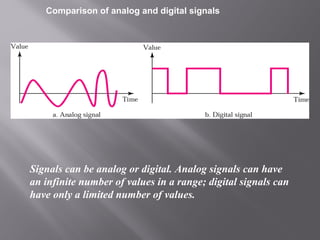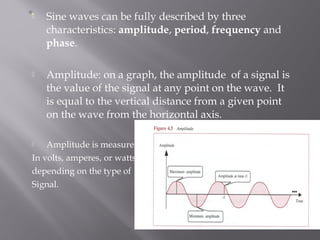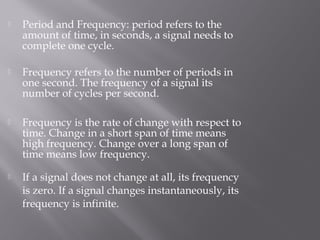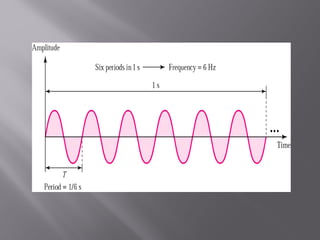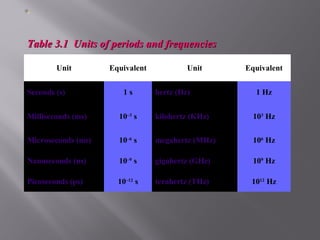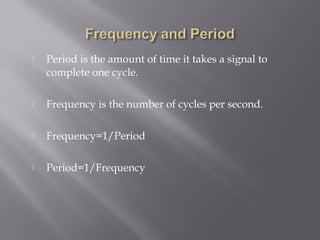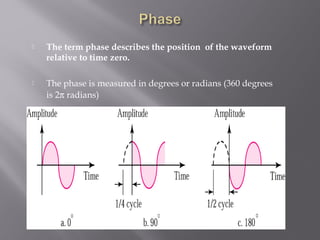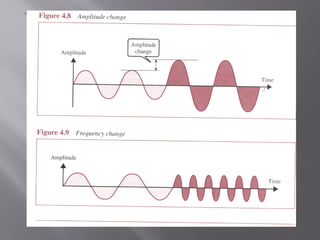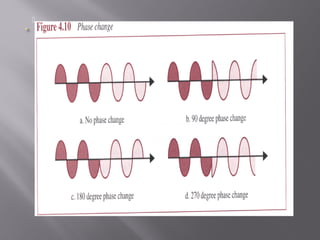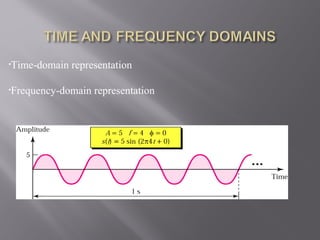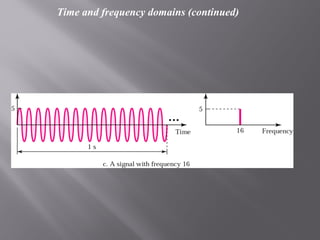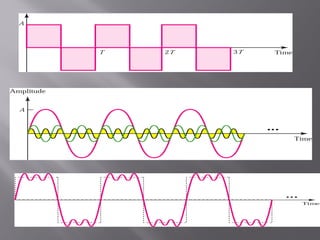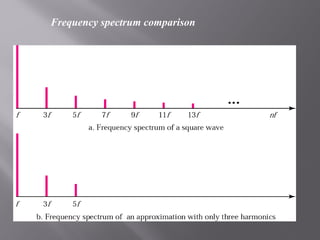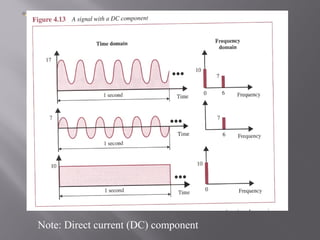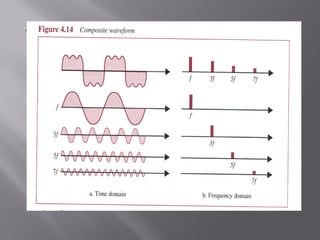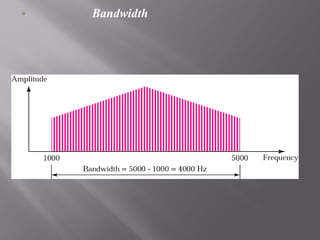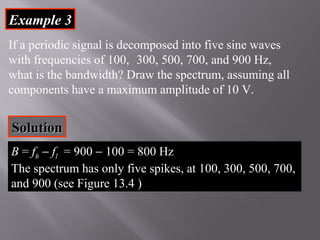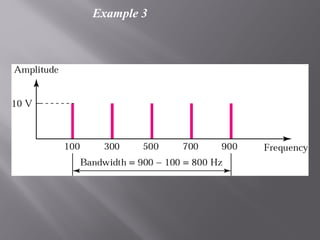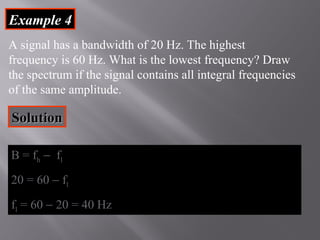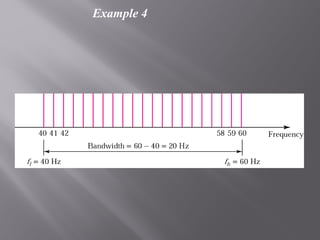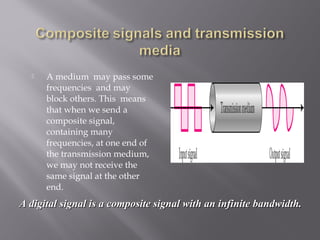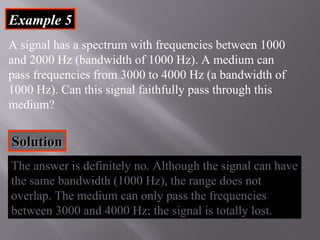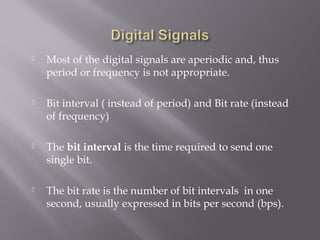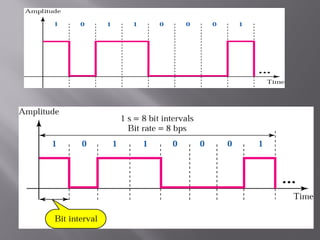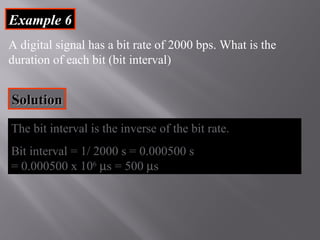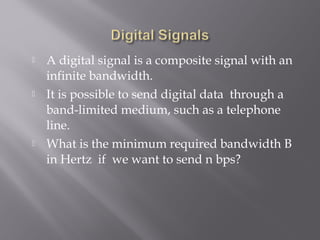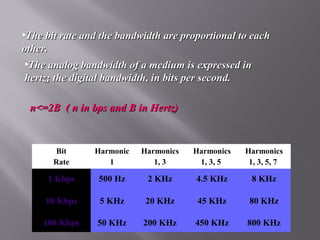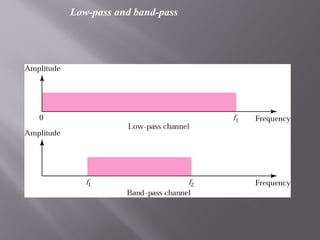Basics of signals data communication
- 1. The main function of the physical layer is moving information in the form of electromagnetic signals across a transmission media. Information can be in the form of data, voice, picture, and so on. Generally the information usable to a person or application is not in a form that can be transmitted over a network.
- 2. The information must be converted into a form that transmission media can accept. Transmission media work by conducting energy along a physical path. So a data stream of 1s and 0s must be turned into energy in the form of electromagnetic signals. A signal is the physical representation of a certain information.
- 3. Signals and data are classified as analog or digital. Analog refers to something that is continuous- a set of data and all possible points between. An example of analog data is the human voice. Digital refers to something that is discrete –a set of specific points of data with no other points in between. An example of digital data is data stored in the memory of a computer in the form of 0s and 1s.
- 4. An analog signal is a continuous wave form that changes smoothly. As the wave moves from a value A to a value B, it passes through and includes an infinite number of values along its path. A digital signal can have only a limited number of defined values, often as simple as 1 and 0.
- 5. Comparison of analog and digital signals Signals can be analog or digital. Analog signals can have an infinite number of values in a range; digital signals can have only a limited number of values.
- 6. Both analog and digital signals can be of two forms: periodic and aperiodic (non-periodic) signals. A signal periodic signal consists a continuously repeated pattern. The completion of one full pattern is called a cycle. A period is defined as the amount of time (expressed in seconds) required to complete one full cycle.
- 7. An aperiodic signal changes constantly without exhibiting a pattern or cycle that repeats over the time. Remark: By using Fourier Transform it is possible to decompose an aperiodic signal into an infinite number of periodic signals (see appendix D)
- 8. Analog signals can be classified as simple or composite. A simple analog signal or sine wave, cannot be decomposed into simpler signals. A composite analog signal is composed of multiple sine waves.
- 9. Sine waves can be fully described by three characteristics: amplitude, period, frequency and phase. Amplitude: on a graph, the amplitude of a signal is the value of the signal at any point on the wave. It is equal to the vertical distance from a given point on the wave from the horizontal axis. Amplitude is measured In volts, amperes, or watts, depending on the type of Signal.
- 10. Period and Frequency: period refers to the amount of time, in seconds, a signal needs to complete one cycle. Frequency refers to the number of periods in one second. The frequency of a signal its number of cycles per second. Frequency is the rate of change with respect to time. Change in a short span of time means high frequency. Change over a long span of time means low frequency. If a signal does not change at all, its frequency is zero. If a signal changes instantaneously, its frequency is infinite.
- 12. Table 3.1 Units ooff ppeerriiooddss aanndd ffrreeqquueenncciieess Unit Equivalent Unit Equivalent Seconds (s) 1 s hertz (Hz) 1 Hz Milliseconds (ms) 10–3 s kilohertz (KHz) 103 Hz Microseconds (ms) 10–6 s megahertz (MHz) 106 Hz Nanoseconds (ns) 10–9 s gigahertz (GHz) 109 Hz Picoseconds (ps) 10–12 s terahertz (THz) 1012 Hz
- 13. Period is the amount of time it takes a signal to complete one cycle. Frequency is the number of cycles per second. Frequency=1/Period Period=1/Frequency
- 14. EExxaammppllee 11 Express a period of 100 ms in microseconds, and express the corresponding frequency in kilohertz. SSoolluuttiioonn From Table 3.1 we find the equivalent of 1 ms.We make the following substitutions: 100 ms = 100 ´ 10-3 s = 100 ´ 10-3 ´ 106 ms = 105 ms Now we use the inverse relationship to find the frequency, changing hertz to kilohertz 100 ms = 100 ´ 10-3 s = 10-1 s f = 1/10-1 Hz = 10 ´ 10-3 KHz = 10-2 KHz
- 15. The term phase describes the position of the waveform relative to time zero. The phase is measured in degrees or radians (360 degrees is 2p radians)
- 17. .
- 18. •Time-domain representation •Frequency-domain representation
- 20. Time and frequency domains
- 21. Time and frequency domains (continued)
- 22. A single-frequency sine wave is not useful in data communications; we need to change one or more of its characteristics to make it useful. According to Fourier analysis, any composite signal can be represented as a combination of simple sine waves with different frequencies, phases, and amplitudes.
- 25. Note: Direct current (DC) component
- 27. The frequency spectrum of a signal is the collection of all the component frequencies it contains and is shown using a frequency-domain graph. The bandwidth of a signal is the width of the frequency spectrum, i.e., bandwidth refers to the range of component frequencies. To compute the bandwidth, subtract the lowest frequency from the highest frequency of the range.
- 28. Bandwidth
- 29. EExxaammppllee 33 If a periodic signal is decomposed into five sine waves with frequencies of 100, 300, 500, 700, and 900 Hz, what is the bandwidth? Draw the spectrum, assuming all components have a maximum amplitude of 10 V. SSoolluuttiioonn B = fh - fl = 900 - 100 = 800 Hz The spectrum has only five spikes, at 100, 300, 500, 700, and 900 (see Figure 13.4 )
- 30. Example 3
- 31. EExxaammppllee 44 A signal has a bandwidth of 20 Hz. The highest frequency is 60 Hz. What is the lowest frequency? Draw the spectrum if the signal contains all integral frequencies of the same amplitude. SSoolluuttiioonn BB == ffhh - ffll 2200 == 6600 - ffll ffll == 6600 - 2200 == 4400 HHzz
- 32. Example 4
- 33. A medium may pass some frequencies and may block others. This means that when we send a composite signal, containing many frequencies, at one end of the transmission medium, we may not receive the same signal at the other end. A digital signal is a composite ssiiggnnaall wwiitthh aann iinnffiinniittee bbaannddwwiiddtthh..
- 34. The range of frequencies that a medium can pass is called its bandwidth. The bandwidth is a property of a medium: It is difference between the highest and the lowest frequencies that the medium can satisfactorily pass. If bandwidth of a medium does not mach the spectrum of a signal, some of the frequencies are lost.
- 35. EExxaammppllee 55 A signal has a spectrum with frequencies between 1000 and 2000 Hz (bandwidth of 1000 Hz). A medium can pass frequencies from 3000 to 4000 Hz (a bandwidth of 1000 Hz). Can this signal faithfully pass through this medium? SSoolluuttiioonn TThhee aannsswweerr iiss ddeeffiinniitteellyy nnoo.. AAlltthhoouugghh tthhee ssiiggnnaall ccaann hhaavvee tthhee ssaammee bbaannddwwiiddtthh ((11000000 HHzz)),, tthhee rraannggee ddooeess nnoott oovveerrllaapp.. TThhee mmeeddiiuumm ccaann oonnllyy ppaassss tthhee ffrreeqquueenncciieess bbeettwweeeenn 33000000 aanndd 44000000 HHzz;; tthhee ssiiggnnaall iiss ttoottaallllyy lloosstt..
- 36. Most of the digital signals are aperiodic and, thus period or frequency is not appropriate. Bit interval ( instead of period) and Bit rate (instead of frequency) The bit interval is the time required to send one single bit. The bit rate is the number of bit intervals in one second, usually expressed in bits per second (bps).
- 38. EExxaammppllee 66 A digital signal has a bit rate of 2000 bps. What is the duration of each bit (bit interval) SSoolluuttiioonn The bit interval is the inverse of the bit rate. Bit interval = 1/ 2000 s = 0.000500 s = 0.000500 x 106 ms = 500 ms
- 39. A digital signal is a composite signal with an infinite bandwidth. It is possible to send digital data through a band-limited medium, such as a telephone line. What is the minimum required bandwidth B in Hertz if we want to send n bps?
- 40. •TThhee bbiitt rraattee aanndd tthhee bbaannddwwiiddtthh aarree pprrooppoorrttiioonnaall ttoo eeaacchh ootthheerr.. •TThhee aannaalloogg bbaannddwwiiddtthh ooff aa mmeeddiiuumm iiss eexxpprreesssseedd iinn hheerrttzz;; tthhee ddiiggiittaall bbaannddwwiiddtthh,, iinn bbiittss ppeerr sseeccoonndd.. nn<<==22BB (( nn iinn bbppss aanndd BB iinn HHeerrttzz)) Bit Rate Harmonic 1 Harmonics 1, 3 Harmonics 1, 3, 5 Harmonics 1, 3, 5, 7 1 Kbps 500 Hz 2 KHz 4.5 KHz 8 KHz 10 Kbps 5 KHz 20 KHz 45 KHz 80 KHz 100 Kbps 50 KHz 200 KHz 450 KHz 800 KHz




